Diabetes and Preventive Measures: Types, Treatments, and Strategies
VerifiedAdded on 2022/12/26
|11
|2168
|33
Essay
AI Summary
This essay delves into the multifaceted world of diabetes, exploring its various types, including type 1 and type 2, and their distinct characteristics. It examines the symptoms associated with each type, highlighting the importance of early detection and management. The essay provides an overview of the SGLT2 treatment, its mechanism, and its role in improving glycemic control. It discusses the significance of health promotion within the community, emphasizing the crucial preventive measures such as nutritious foods, physical activity, and self-management to combat the disease. Furthermore, the essay references the Diabetes Control and Complications Trial (DCCT) and includes a personal reflection on the researcher's experience with diabetes, underscoring the practical aspects of managing the condition through lifestyle adjustments. The essay emphasizes the need for government initiatives and standardized practices to mitigate the prevalence of diabetes. The essay stresses the importance of health promotion awareness, community-based primary care, and accessible resources to reduce the impact of diabetes.

Running Head: DIABETES AND PREVENTIVE MEASURES 1
NURSING
STUDENT’S NAME
COURSE
UNIVERSITY
DATE
NURSING
STUDENT’S NAME
COURSE
UNIVERSITY
DATE
Paraphrase This Document
Need a fresh take? Get an instant paraphrase of this document with our AI Paraphraser
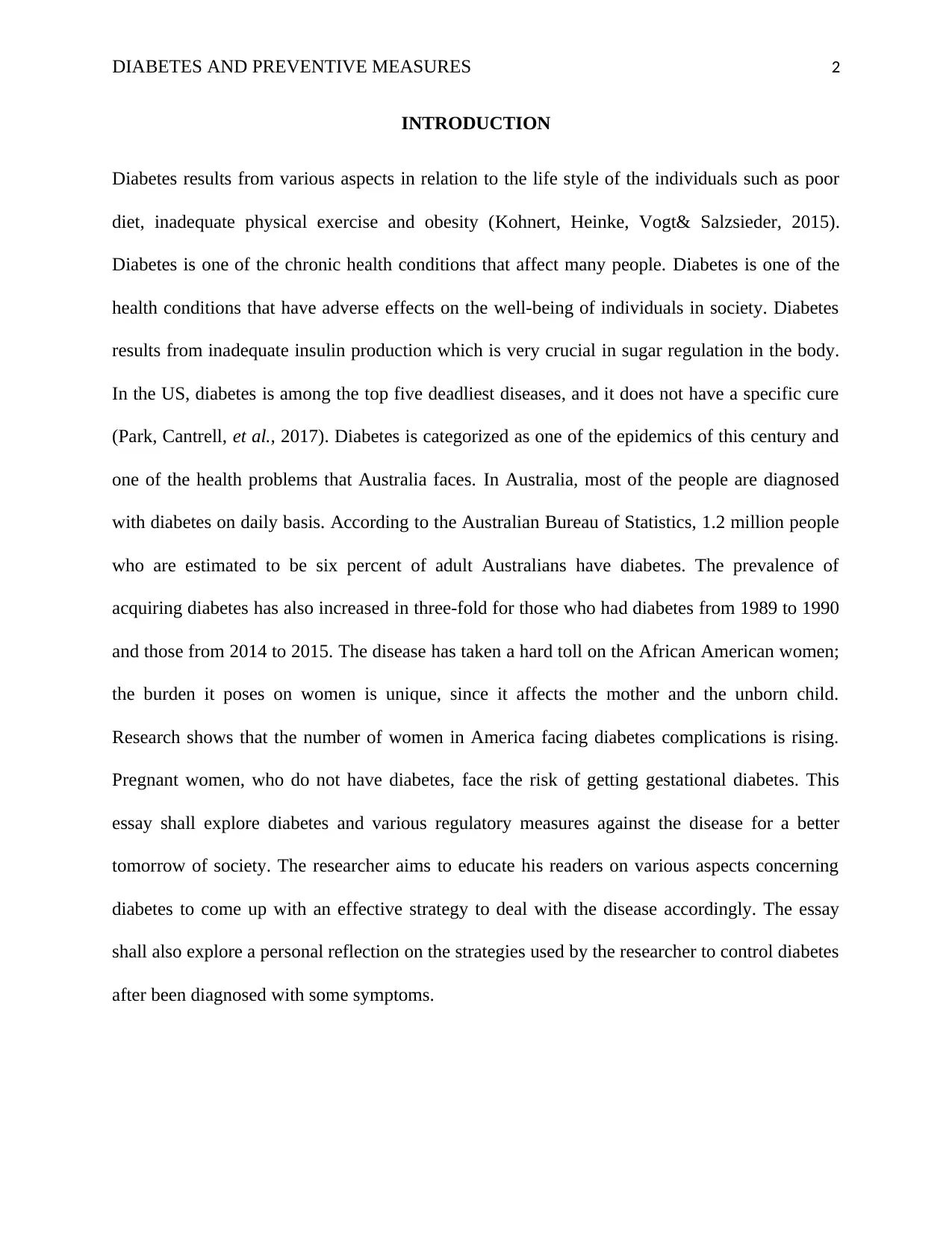
DIABETES AND PREVENTIVE MEASURES 2
INTRODUCTION
Diabetes results from various aspects in relation to the life style of the individuals such as poor
diet, inadequate physical exercise and obesity (Kohnert, Heinke, Vogt& Salzsieder, 2015).
Diabetes is one of the chronic health conditions that affect many people. Diabetes is one of the
health conditions that have adverse effects on the well-being of individuals in society. Diabetes
results from inadequate insulin production which is very crucial in sugar regulation in the body.
In the US, diabetes is among the top five deadliest diseases, and it does not have a specific cure
(Park, Cantrell, et al., 2017). Diabetes is categorized as one of the epidemics of this century and
one of the health problems that Australia faces. In Australia, most of the people are diagnosed
with diabetes on daily basis. According to the Australian Bureau of Statistics, 1.2 million people
who are estimated to be six percent of adult Australians have diabetes. The prevalence of
acquiring diabetes has also increased in three-fold for those who had diabetes from 1989 to 1990
and those from 2014 to 2015. The disease has taken a hard toll on the African American women;
the burden it poses on women is unique, since it affects the mother and the unborn child.
Research shows that the number of women in America facing diabetes complications is rising.
Pregnant women, who do not have diabetes, face the risk of getting gestational diabetes. This
essay shall explore diabetes and various regulatory measures against the disease for a better
tomorrow of society. The researcher aims to educate his readers on various aspects concerning
diabetes to come up with an effective strategy to deal with the disease accordingly. The essay
shall also explore a personal reflection on the strategies used by the researcher to control diabetes
after been diagnosed with some symptoms.
INTRODUCTION
Diabetes results from various aspects in relation to the life style of the individuals such as poor
diet, inadequate physical exercise and obesity (Kohnert, Heinke, Vogt& Salzsieder, 2015).
Diabetes is one of the chronic health conditions that affect many people. Diabetes is one of the
health conditions that have adverse effects on the well-being of individuals in society. Diabetes
results from inadequate insulin production which is very crucial in sugar regulation in the body.
In the US, diabetes is among the top five deadliest diseases, and it does not have a specific cure
(Park, Cantrell, et al., 2017). Diabetes is categorized as one of the epidemics of this century and
one of the health problems that Australia faces. In Australia, most of the people are diagnosed
with diabetes on daily basis. According to the Australian Bureau of Statistics, 1.2 million people
who are estimated to be six percent of adult Australians have diabetes. The prevalence of
acquiring diabetes has also increased in three-fold for those who had diabetes from 1989 to 1990
and those from 2014 to 2015. The disease has taken a hard toll on the African American women;
the burden it poses on women is unique, since it affects the mother and the unborn child.
Research shows that the number of women in America facing diabetes complications is rising.
Pregnant women, who do not have diabetes, face the risk of getting gestational diabetes. This
essay shall explore diabetes and various regulatory measures against the disease for a better
tomorrow of society. The researcher aims to educate his readers on various aspects concerning
diabetes to come up with an effective strategy to deal with the disease accordingly. The essay
shall also explore a personal reflection on the strategies used by the researcher to control diabetes
after been diagnosed with some symptoms.
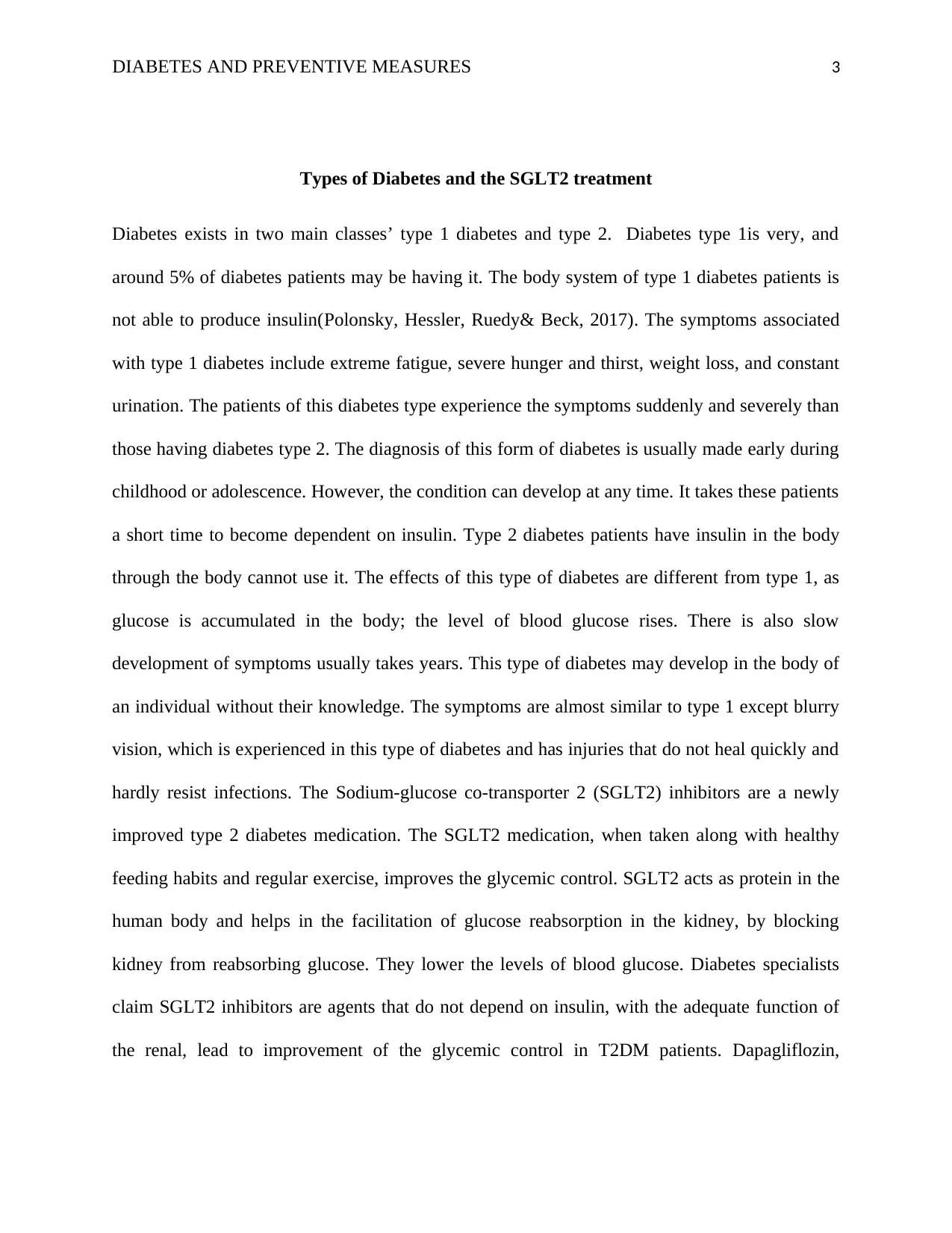
DIABETES AND PREVENTIVE MEASURES 3
Types of Diabetes and the SGLT2 treatment
Diabetes exists in two main classes’ type 1 diabetes and type 2. Diabetes type 1is very, and
around 5% of diabetes patients may be having it. The body system of type 1 diabetes patients is
not able to produce insulin(Polonsky, Hessler, Ruedy& Beck, 2017). The symptoms associated
with type 1 diabetes include extreme fatigue, severe hunger and thirst, weight loss, and constant
urination. The patients of this diabetes type experience the symptoms suddenly and severely than
those having diabetes type 2. The diagnosis of this form of diabetes is usually made early during
childhood or adolescence. However, the condition can develop at any time. It takes these patients
a short time to become dependent on insulin. Type 2 diabetes patients have insulin in the body
through the body cannot use it. The effects of this type of diabetes are different from type 1, as
glucose is accumulated in the body; the level of blood glucose rises. There is also slow
development of symptoms usually takes years. This type of diabetes may develop in the body of
an individual without their knowledge. The symptoms are almost similar to type 1 except blurry
vision, which is experienced in this type of diabetes and has injuries that do not heal quickly and
hardly resist infections. The Sodium-glucose co-transporter 2 (SGLT2) inhibitors are a newly
improved type 2 diabetes medication. The SGLT2 medication, when taken along with healthy
feeding habits and regular exercise, improves the glycemic control. SGLT2 acts as protein in the
human body and helps in the facilitation of glucose reabsorption in the kidney, by blocking
kidney from reabsorbing glucose. They lower the levels of blood glucose. Diabetes specialists
claim SGLT2 inhibitors are agents that do not depend on insulin, with the adequate function of
the renal, lead to improvement of the glycemic control in T2DM patients. Dapagliflozin,
Types of Diabetes and the SGLT2 treatment
Diabetes exists in two main classes’ type 1 diabetes and type 2. Diabetes type 1is very, and
around 5% of diabetes patients may be having it. The body system of type 1 diabetes patients is
not able to produce insulin(Polonsky, Hessler, Ruedy& Beck, 2017). The symptoms associated
with type 1 diabetes include extreme fatigue, severe hunger and thirst, weight loss, and constant
urination. The patients of this diabetes type experience the symptoms suddenly and severely than
those having diabetes type 2. The diagnosis of this form of diabetes is usually made early during
childhood or adolescence. However, the condition can develop at any time. It takes these patients
a short time to become dependent on insulin. Type 2 diabetes patients have insulin in the body
through the body cannot use it. The effects of this type of diabetes are different from type 1, as
glucose is accumulated in the body; the level of blood glucose rises. There is also slow
development of symptoms usually takes years. This type of diabetes may develop in the body of
an individual without their knowledge. The symptoms are almost similar to type 1 except blurry
vision, which is experienced in this type of diabetes and has injuries that do not heal quickly and
hardly resist infections. The Sodium-glucose co-transporter 2 (SGLT2) inhibitors are a newly
improved type 2 diabetes medication. The SGLT2 medication, when taken along with healthy
feeding habits and regular exercise, improves the glycemic control. SGLT2 acts as protein in the
human body and helps in the facilitation of glucose reabsorption in the kidney, by blocking
kidney from reabsorbing glucose. They lower the levels of blood glucose. Diabetes specialists
claim SGLT2 inhibitors are agents that do not depend on insulin, with the adequate function of
the renal, lead to improvement of the glycemic control in T2DM patients. Dapagliflozin,
⊘ This is a preview!⊘
Do you want full access?
Subscribe today to unlock all pages.

Trusted by 1+ million students worldwide
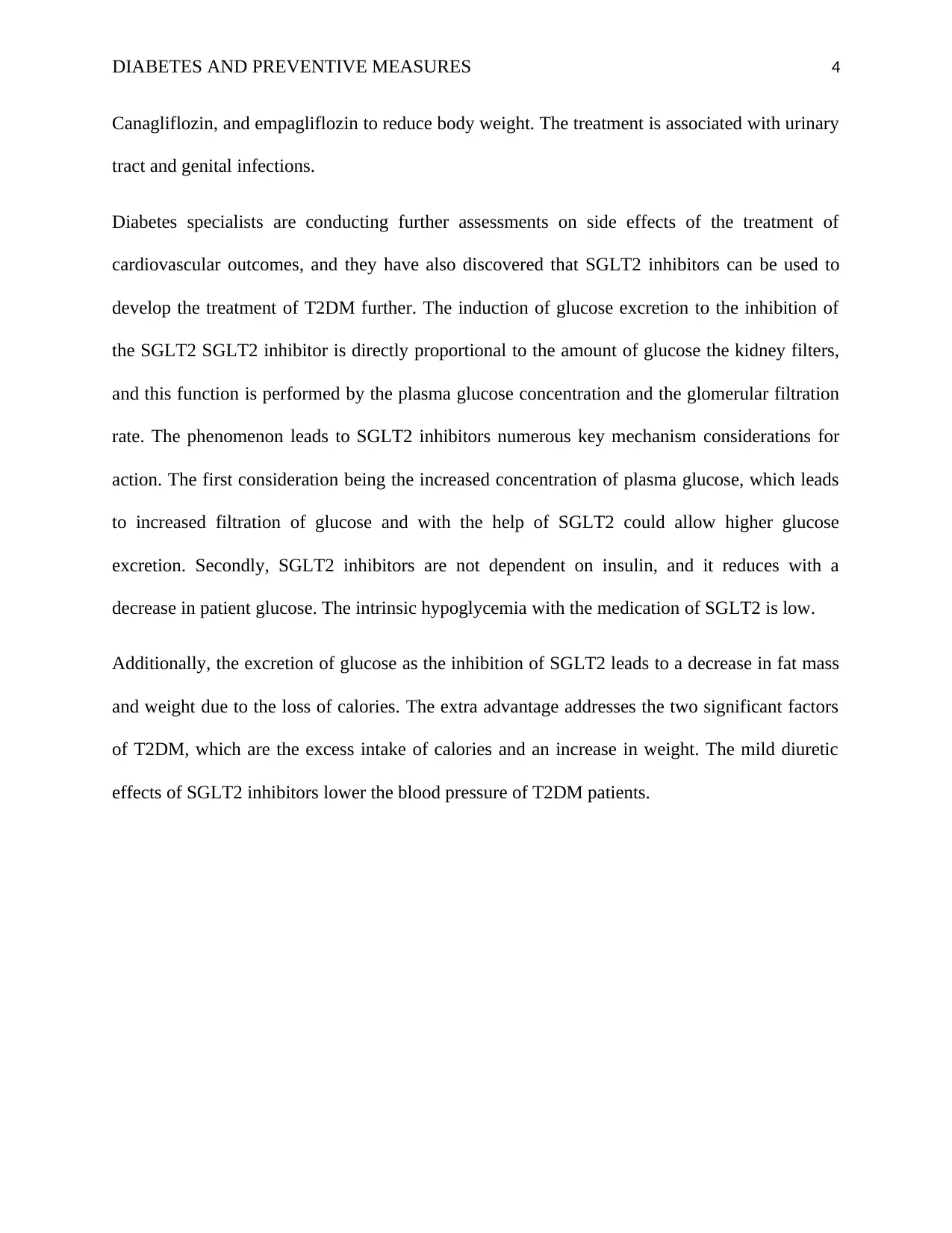
DIABETES AND PREVENTIVE MEASURES 4
Canagliflozin, and empagliflozin to reduce body weight. The treatment is associated with urinary
tract and genital infections.
Diabetes specialists are conducting further assessments on side effects of the treatment of
cardiovascular outcomes, and they have also discovered that SGLT2 inhibitors can be used to
develop the treatment of T2DM further. The induction of glucose excretion to the inhibition of
the SGLT2 SGLT2 inhibitor is directly proportional to the amount of glucose the kidney filters,
and this function is performed by the plasma glucose concentration and the glomerular filtration
rate. The phenomenon leads to SGLT2 inhibitors numerous key mechanism considerations for
action. The first consideration being the increased concentration of plasma glucose, which leads
to increased filtration of glucose and with the help of SGLT2 could allow higher glucose
excretion. Secondly, SGLT2 inhibitors are not dependent on insulin, and it reduces with a
decrease in patient glucose. The intrinsic hypoglycemia with the medication of SGLT2 is low.
Additionally, the excretion of glucose as the inhibition of SGLT2 leads to a decrease in fat mass
and weight due to the loss of calories. The extra advantage addresses the two significant factors
of T2DM, which are the excess intake of calories and an increase in weight. The mild diuretic
effects of SGLT2 inhibitors lower the blood pressure of T2DM patients.
Canagliflozin, and empagliflozin to reduce body weight. The treatment is associated with urinary
tract and genital infections.
Diabetes specialists are conducting further assessments on side effects of the treatment of
cardiovascular outcomes, and they have also discovered that SGLT2 inhibitors can be used to
develop the treatment of T2DM further. The induction of glucose excretion to the inhibition of
the SGLT2 SGLT2 inhibitor is directly proportional to the amount of glucose the kidney filters,
and this function is performed by the plasma glucose concentration and the glomerular filtration
rate. The phenomenon leads to SGLT2 inhibitors numerous key mechanism considerations for
action. The first consideration being the increased concentration of plasma glucose, which leads
to increased filtration of glucose and with the help of SGLT2 could allow higher glucose
excretion. Secondly, SGLT2 inhibitors are not dependent on insulin, and it reduces with a
decrease in patient glucose. The intrinsic hypoglycemia with the medication of SGLT2 is low.
Additionally, the excretion of glucose as the inhibition of SGLT2 leads to a decrease in fat mass
and weight due to the loss of calories. The extra advantage addresses the two significant factors
of T2DM, which are the excess intake of calories and an increase in weight. The mild diuretic
effects of SGLT2 inhibitors lower the blood pressure of T2DM patients.
Paraphrase This Document
Need a fresh take? Get an instant paraphrase of this document with our AI Paraphraser
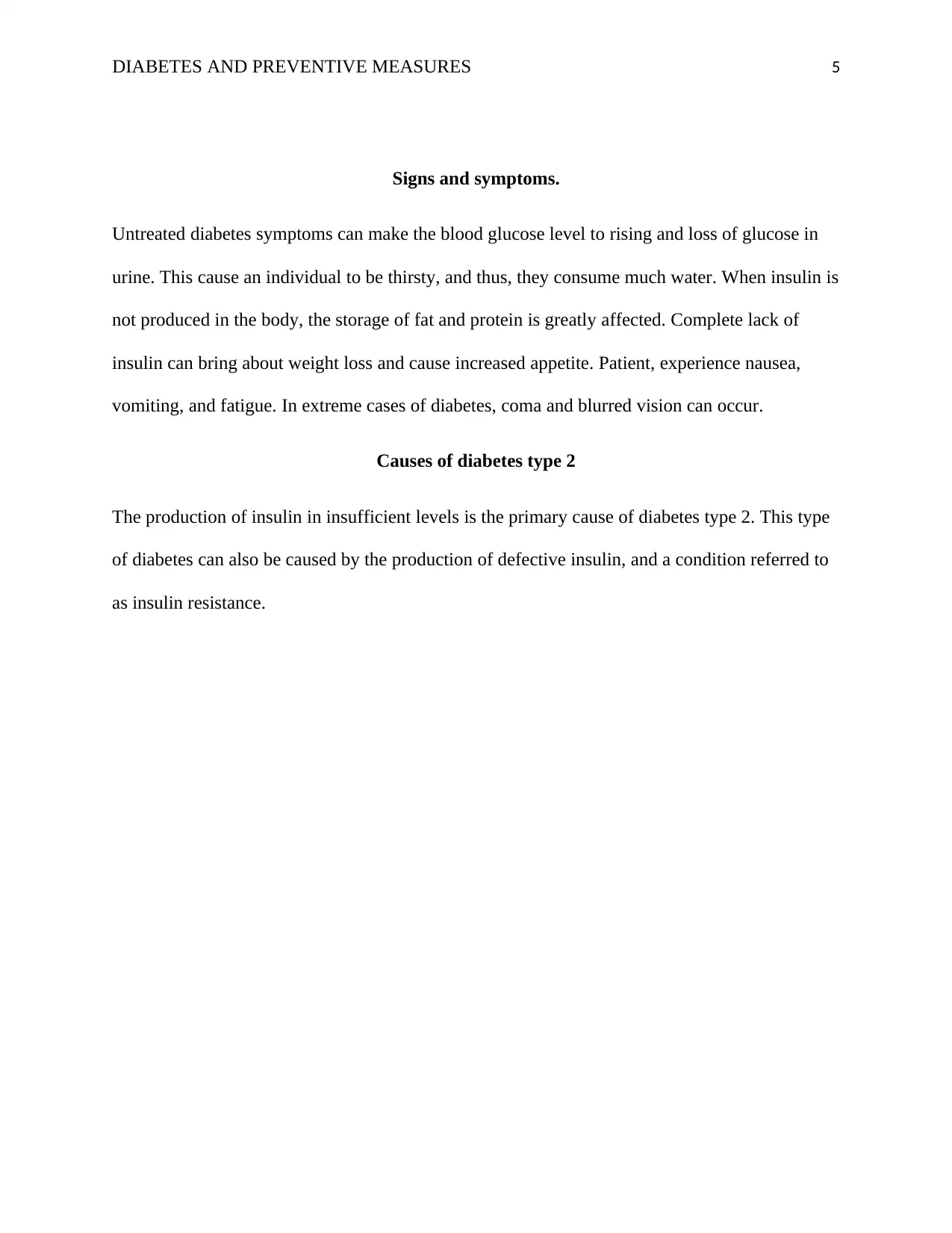
DIABETES AND PREVENTIVE MEASURES 5
Signs and symptoms.
Untreated diabetes symptoms can make the blood glucose level to rising and loss of glucose in
urine. This cause an individual to be thirsty, and thus, they consume much water. When insulin is
not produced in the body, the storage of fat and protein is greatly affected. Complete lack of
insulin can bring about weight loss and cause increased appetite. Patient, experience nausea,
vomiting, and fatigue. In extreme cases of diabetes, coma and blurred vision can occur.
Causes of diabetes type 2
The production of insulin in insufficient levels is the primary cause of diabetes type 2. This type
of diabetes can also be caused by the production of defective insulin, and a condition referred to
as insulin resistance.
Signs and symptoms.
Untreated diabetes symptoms can make the blood glucose level to rising and loss of glucose in
urine. This cause an individual to be thirsty, and thus, they consume much water. When insulin is
not produced in the body, the storage of fat and protein is greatly affected. Complete lack of
insulin can bring about weight loss and cause increased appetite. Patient, experience nausea,
vomiting, and fatigue. In extreme cases of diabetes, coma and blurred vision can occur.
Causes of diabetes type 2
The production of insulin in insufficient levels is the primary cause of diabetes type 2. This type
of diabetes can also be caused by the production of defective insulin, and a condition referred to
as insulin resistance.
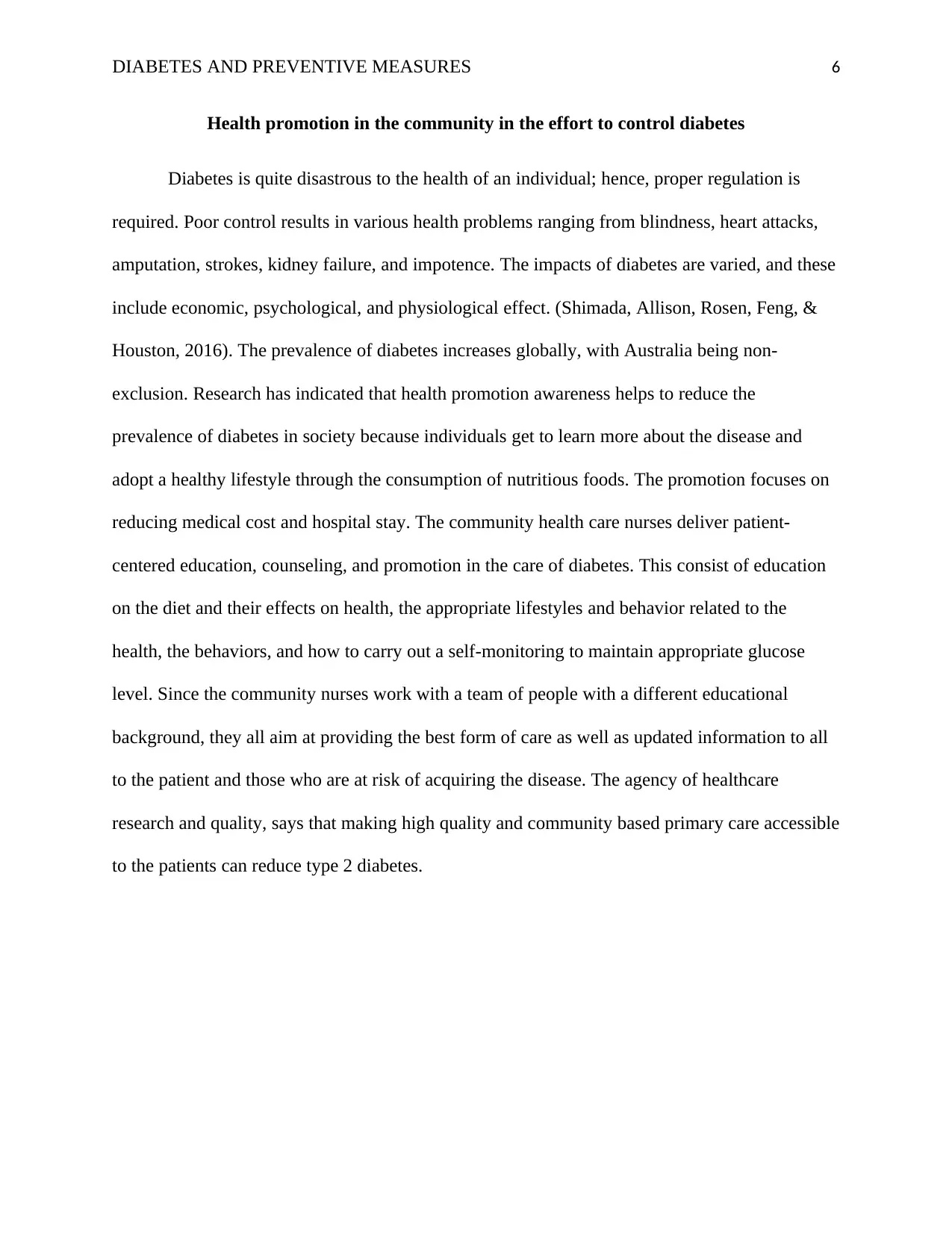
DIABETES AND PREVENTIVE MEASURES 6
Health promotion in the community in the effort to control diabetes
Diabetes is quite disastrous to the health of an individual; hence, proper regulation is
required. Poor control results in various health problems ranging from blindness, heart attacks,
amputation, strokes, kidney failure, and impotence. The impacts of diabetes are varied, and these
include economic, psychological, and physiological effect. (Shimada, Allison, Rosen, Feng, &
Houston, 2016). The prevalence of diabetes increases globally, with Australia being non-
exclusion. Research has indicated that health promotion awareness helps to reduce the
prevalence of diabetes in society because individuals get to learn more about the disease and
adopt a healthy lifestyle through the consumption of nutritious foods. The promotion focuses on
reducing medical cost and hospital stay. The community health care nurses deliver patient-
centered education, counseling, and promotion in the care of diabetes. This consist of education
on the diet and their effects on health, the appropriate lifestyles and behavior related to the
health, the behaviors, and how to carry out a self-monitoring to maintain appropriate glucose
level. Since the community nurses work with a team of people with a different educational
background, they all aim at providing the best form of care as well as updated information to all
to the patient and those who are at risk of acquiring the disease. The agency of healthcare
research and quality, says that making high quality and community based primary care accessible
to the patients can reduce type 2 diabetes.
Health promotion in the community in the effort to control diabetes
Diabetes is quite disastrous to the health of an individual; hence, proper regulation is
required. Poor control results in various health problems ranging from blindness, heart attacks,
amputation, strokes, kidney failure, and impotence. The impacts of diabetes are varied, and these
include economic, psychological, and physiological effect. (Shimada, Allison, Rosen, Feng, &
Houston, 2016). The prevalence of diabetes increases globally, with Australia being non-
exclusion. Research has indicated that health promotion awareness helps to reduce the
prevalence of diabetes in society because individuals get to learn more about the disease and
adopt a healthy lifestyle through the consumption of nutritious foods. The promotion focuses on
reducing medical cost and hospital stay. The community health care nurses deliver patient-
centered education, counseling, and promotion in the care of diabetes. This consist of education
on the diet and their effects on health, the appropriate lifestyles and behavior related to the
health, the behaviors, and how to carry out a self-monitoring to maintain appropriate glucose
level. Since the community nurses work with a team of people with a different educational
background, they all aim at providing the best form of care as well as updated information to all
to the patient and those who are at risk of acquiring the disease. The agency of healthcare
research and quality, says that making high quality and community based primary care accessible
to the patients can reduce type 2 diabetes.
⊘ This is a preview!⊘
Do you want full access?
Subscribe today to unlock all pages.

Trusted by 1+ million students worldwide
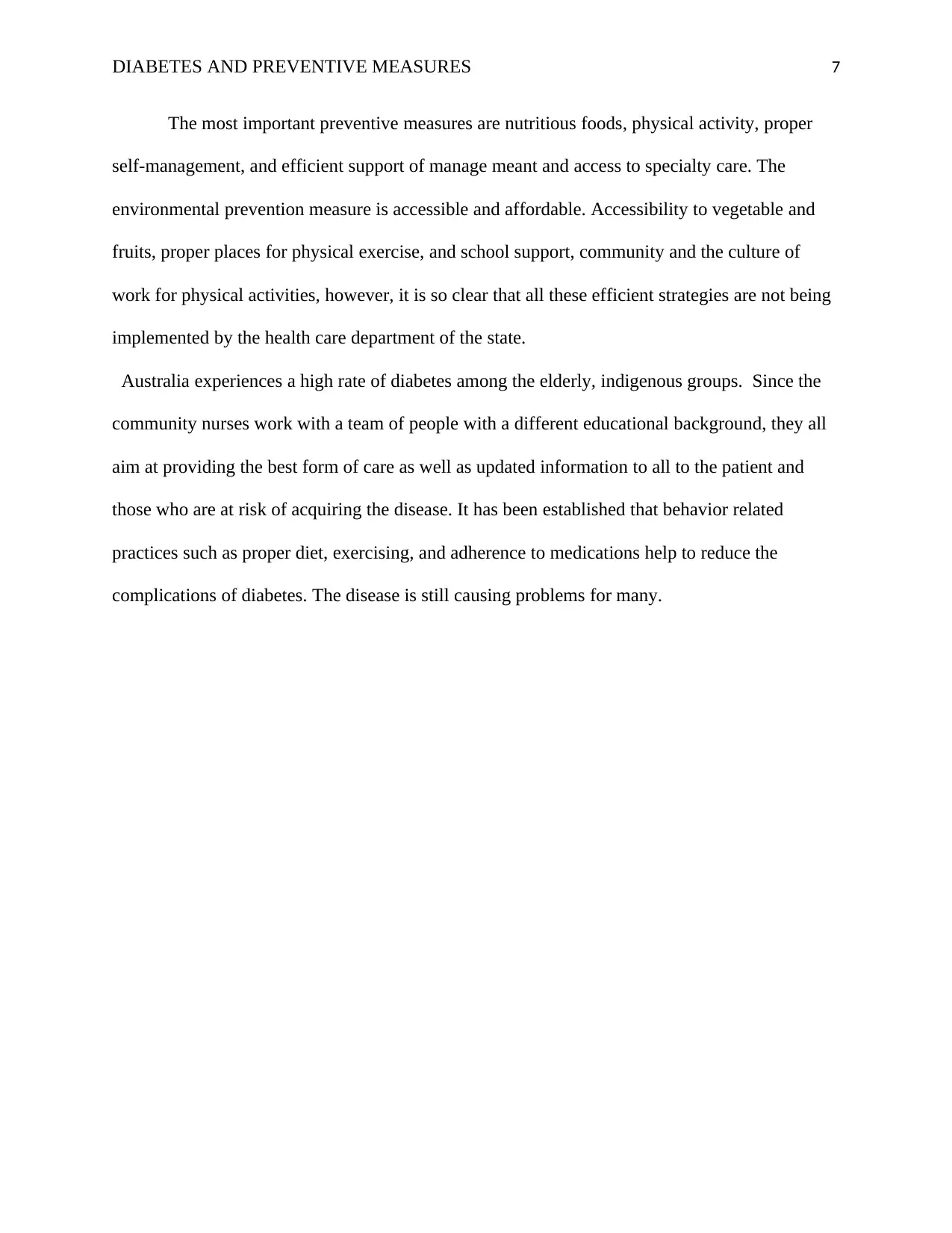
DIABETES AND PREVENTIVE MEASURES 7
The most important preventive measures are nutritious foods, physical activity, proper
self-management, and efficient support of manage meant and access to specialty care. The
environmental prevention measure is accessible and affordable. Accessibility to vegetable and
fruits, proper places for physical exercise, and school support, community and the culture of
work for physical activities, however, it is so clear that all these efficient strategies are not being
implemented by the health care department of the state.
Australia experiences a high rate of diabetes among the elderly, indigenous groups. Since the
community nurses work with a team of people with a different educational background, they all
aim at providing the best form of care as well as updated information to all to the patient and
those who are at risk of acquiring the disease. It has been established that behavior related
practices such as proper diet, exercising, and adherence to medications help to reduce the
complications of diabetes. The disease is still causing problems for many.
The most important preventive measures are nutritious foods, physical activity, proper
self-management, and efficient support of manage meant and access to specialty care. The
environmental prevention measure is accessible and affordable. Accessibility to vegetable and
fruits, proper places for physical exercise, and school support, community and the culture of
work for physical activities, however, it is so clear that all these efficient strategies are not being
implemented by the health care department of the state.
Australia experiences a high rate of diabetes among the elderly, indigenous groups. Since the
community nurses work with a team of people with a different educational background, they all
aim at providing the best form of care as well as updated information to all to the patient and
those who are at risk of acquiring the disease. It has been established that behavior related
practices such as proper diet, exercising, and adherence to medications help to reduce the
complications of diabetes. The disease is still causing problems for many.
Paraphrase This Document
Need a fresh take? Get an instant paraphrase of this document with our AI Paraphraser

DIABETES AND PREVENTIVE MEASURES 8
The Diabetes Control and Complications Trial (DCCT)
A Diabetes Control and Complications Trial was first conducted from1983 to 1993. It
was an initiative of the National Institute of Diabetes and Digestive and Kidney Diseases. In the
study, it was discovered that by keeping the blood sugar level as close to the normal as possible
lows the possibility of the onset of some health complications such as eyes, nerve damage and
even the kidney damages that are mainly liked by the condition of diabetes. It was found that
lowing blood glucose increases the chance of control even in cases of poor control. For the
diabetic condition to be fully resolved from the society, the blood glucose close to the normal is
the central aspect that the physicians should take into serious consideration. If the aspect of blood
glucose level would be given the weight that it deserves, then the aspect of diabetes will be
resolved once and for all.
The Diabetes Control and Complications Trial (DCCT)
A Diabetes Control and Complications Trial was first conducted from1983 to 1993. It
was an initiative of the National Institute of Diabetes and Digestive and Kidney Diseases. In the
study, it was discovered that by keeping the blood sugar level as close to the normal as possible
lows the possibility of the onset of some health complications such as eyes, nerve damage and
even the kidney damages that are mainly liked by the condition of diabetes. It was found that
lowing blood glucose increases the chance of control even in cases of poor control. For the
diabetic condition to be fully resolved from the society, the blood glucose close to the normal is
the central aspect that the physicians should take into serious consideration. If the aspect of blood
glucose level would be given the weight that it deserves, then the aspect of diabetes will be
resolved once and for all.
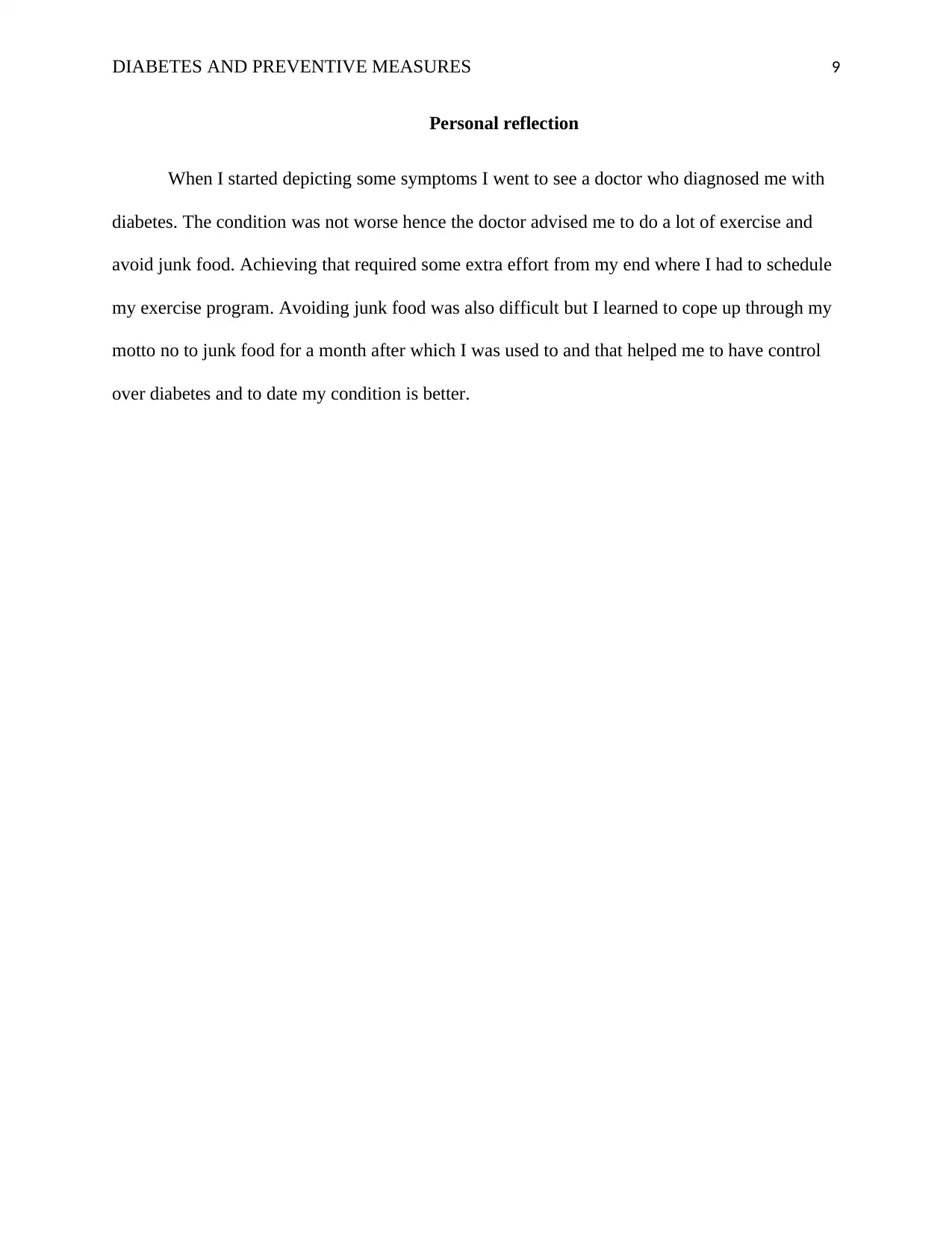
DIABETES AND PREVENTIVE MEASURES 9
Personal reflection
When I started depicting some symptoms I went to see a doctor who diagnosed me with
diabetes. The condition was not worse hence the doctor advised me to do a lot of exercise and
avoid junk food. Achieving that required some extra effort from my end where I had to schedule
my exercise program. Avoiding junk food was also difficult but I learned to cope up through my
motto no to junk food for a month after which I was used to and that helped me to have control
over diabetes and to date my condition is better.
Personal reflection
When I started depicting some symptoms I went to see a doctor who diagnosed me with
diabetes. The condition was not worse hence the doctor advised me to do a lot of exercise and
avoid junk food. Achieving that required some extra effort from my end where I had to schedule
my exercise program. Avoiding junk food was also difficult but I learned to cope up through my
motto no to junk food for a month after which I was used to and that helped me to have control
over diabetes and to date my condition is better.
⊘ This is a preview!⊘
Do you want full access?
Subscribe today to unlock all pages.

Trusted by 1+ million students worldwide
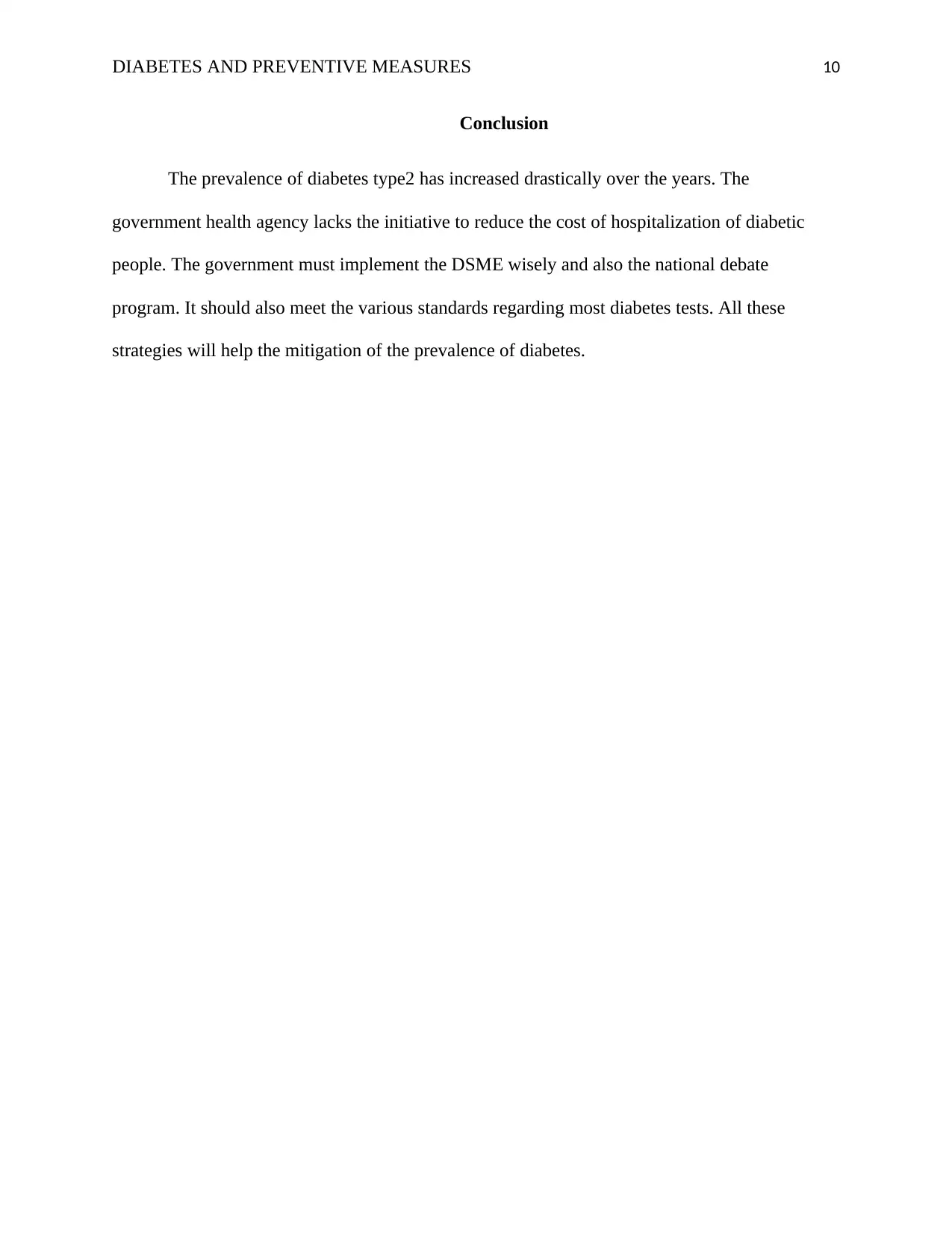
DIABETES AND PREVENTIVE MEASURES 10
Conclusion
The prevalence of diabetes type2 has increased drastically over the years. The
government health agency lacks the initiative to reduce the cost of hospitalization of diabetic
people. The government must implement the DSME wisely and also the national debate
program. It should also meet the various standards regarding most diabetes tests. All these
strategies will help the mitigation of the prevalence of diabetes.
Conclusion
The prevalence of diabetes type2 has increased drastically over the years. The
government health agency lacks the initiative to reduce the cost of hospitalization of diabetic
people. The government must implement the DSME wisely and also the national debate
program. It should also meet the various standards regarding most diabetes tests. All these
strategies will help the mitigation of the prevalence of diabetes.
Paraphrase This Document
Need a fresh take? Get an instant paraphrase of this document with our AI Paraphraser

DIABETES AND PREVENTIVE MEASURES 11
References
Kohnert, K. D., Heinke, P., Vogt, L., & Salzsieder, E. (2015). The utility of different glycemic
control metrics for optimizing management of diabetes. World journal of diabetes, 6(1),
17.
Park, B. Z., Cantrell, L., Hunt, H., Farris, R. P., Schumacher, P., & Bauer, U. E. (2017). State
Public Health Actions to Prevent and Control Diabetes, Heart Disease, Obesity, and
Associated Risk Factors, and Promote School Health. Preventing chronic disease, 14,
E127-E127.
Polonsky, W. H., Hessler, D., Ruedy, K. J., & Beck, R. W. (2017). The impact of continuous
glucose monitoring on markers of quality of life in adults with type 1 diabetes: further
findings from the DIAMOND randomized clinical trial. Diabetes Care, 40(6), 736-741.
Shimada, S. L., Allison, J. J., Rosen, A. K., Feng, H., & Houston, T. K. (2016). Sustained use of
patient portal features and improvements in diabetes physiological measures — Journal
of medical Internet research, 18(7), e179.
References
Kohnert, K. D., Heinke, P., Vogt, L., & Salzsieder, E. (2015). The utility of different glycemic
control metrics for optimizing management of diabetes. World journal of diabetes, 6(1),
17.
Park, B. Z., Cantrell, L., Hunt, H., Farris, R. P., Schumacher, P., & Bauer, U. E. (2017). State
Public Health Actions to Prevent and Control Diabetes, Heart Disease, Obesity, and
Associated Risk Factors, and Promote School Health. Preventing chronic disease, 14,
E127-E127.
Polonsky, W. H., Hessler, D., Ruedy, K. J., & Beck, R. W. (2017). The impact of continuous
glucose monitoring on markers of quality of life in adults with type 1 diabetes: further
findings from the DIAMOND randomized clinical trial. Diabetes Care, 40(6), 736-741.
Shimada, S. L., Allison, J. J., Rosen, A. K., Feng, H., & Houston, T. K. (2016). Sustained use of
patient portal features and improvements in diabetes physiological measures — Journal
of medical Internet research, 18(7), e179.
1 out of 11